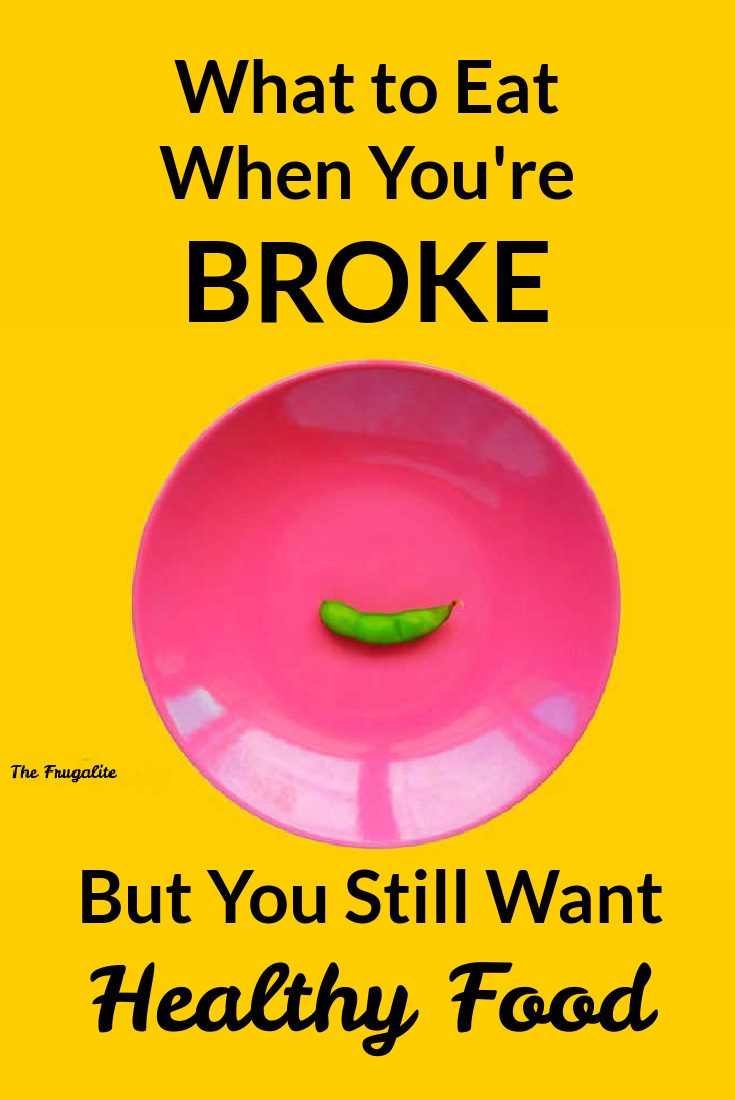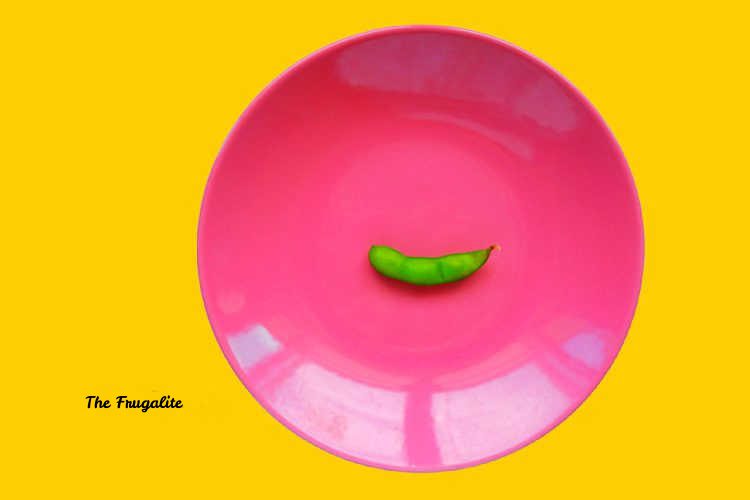(Psst: The FTC wants me to remind you that this website contains affiliate links. That means if you make a purchase from a link you click on, I might receive a small commission. This does not increase the price you’ll pay for that item nor does it decrease the awesomeness of the item. ~ Daisy)
The lower your income is, the more difficult it is to be particular about what you feed your family. What to eat when you’re broke can easily turn into a paralyzing decision – ESPECIALLY if you don’t want to be eating ramen and Pringles all day.
This probably isn’t an earth-shattering revelation to anyone, but if you feel like experimenting, try to buy a week’s worth of healthy food for a family on a budget of, say, $50-75. Food manufacturers that target lower-income shoppers with more affordable products tend to include more GMOs and toxic ingredients in their offerings.
Sometimes, it just isn’t possible to stick to my usual food restrictions. Generally speaking, I avoid:
- Non-organic dairy because of the hormones and antibiotics as well as the GMO feed given to the animals
- Non-organic meat because of the hormones and antibiotics as well as the GMO feed given to the animals
- Anything containing corn, soy, or canola in any form because it is almost certain to be GMO
- Anything with chemical additives like artificial colors, flavors, or preservatives
- Anything that is likely to have been doused in pesticides
- Anything containing neurotoxins like MSG, fluoride, or aspartame (along with other artificial sweeteners)
It is a matter, then, of weighing the pros and cons, and figuring out what things, for you, are the most important, while also deciding which standards can be sacrificed. These decisions will be different for everyone, based on their personal health concerns, their genetic propensity for certain diseases, and the members of the family for whom they are buying the food.
Sometimes, when you’re looking at someone else’s situation while you’re comfortably backed by a loaded pantry, it’s easy to be judgemental and tell them what they “should” do. The thing that we must all remember is that when times are tough, a person may be down to these two options with a two-week grocery budget:
1.) Buy strictly healthy organic foods and feed your family for perhaps 8 out of the 14 days.
2.) Carefully select which standards you will relax to keep the tummies of your family full throughout the wait for the next paycheck.
Very few people are going to choose option one.
Usually, I have an enormous stockpile of non-GMO dried foods and a flourishing garden to serve as a back-up for whatever non-toxic items are being offered at a reasonable price that week. But back when I moved from Canada to the US, I found myself rebuilding my pantry from the ground up. I had no such stockpile and I was at the mercy of the food manufacturers.
When your budget is extremely limited, the normal healthy eating suggestions of shopping only the perimeter of the store or visiting the farmer’s market will not suffice to feed a family. As much as you may want to dine on only locally grown, fresh, organic produce, a $50 farmer’s market spree will only get you through a few days if you are totally reliant on ONLY this food.
The Lesser of the Nutritional Evils
So what is a broke, but health-conscious, shopper to eat?
If you are in a situation where you have to feed your family and don’t have a lot of money to do it, you need to do your research before looking at those brightly colored packages with false promises of nutrition within. While this list isn’t comprehensive, here are some things to consider about conventional grocery store offerings…
GMOs: Genetically modified foods have not been tested for long-term effects on humans. There is some evidence to indicate GMOs can cause a host of illness. But one thing IS for certain – many genetically modified food crops are altered so that they can survive a much higher dousing of toxic pesticides and herbicides. This increased dosage would kill other foods. Do you want to eat that? Some of them even have the herbicide built right in. If I’m avoiding pesticides as much as possible, why on earth would I eat food that is treated with an even greater amount of toxic chemicals?
Hormones and antibiotics: Livestock animals that provide meat or dairy products are tainted with growth hormones, antibiotics, and GMO feed. These items pass through the food chain to the consumer. Growth hormones can cause opposite sex characteristics in developing children, early puberty, the development of cancer, and infertility. Furthermore, the world is quickly becoming immune to the effects of antibiotics because of constant exposure through the food supply, which means that there is the potential for things that should be easily treated to become deadly due to antibiotic resistance.
Pesticides/Herbicides: The use of pesticides and herbicides in conventional farming is rampant. Even the Environmental Protection Agency has to admit that the ingestion of these chemicals can cause health problems. They warn of the risk of “birth defects, nerve damage, cancer, and other effects that might occur over a long period of time.” (Keep in mind, however, that despite this warning, the EPA RAISED the acceptable limit of glyphosate at the behest of Monsanto.) Especially at risk of harm from pesticides/herbicides are prepubescent children and fetuses.
Neurotoxins: Our water supply is spiked with fluoride, a neurotoxin that lowers IQ, causes infertility, has been linked to cancer and causes hardening of the arteries. Nearly every packaged food on the shelf is seasoned with MSG in one of its many names, and many lower calorie foods and diet drinks are sweetened with aspartame. Both of these are excitotoxins that cause brain cell death instantly, causing decreased IQs, headaches, depression, and seizures.
Assorted chemical cocktails: The length of the ingredients list in your food is often a direct indicator of the unhealthiness of the item. When an item contains a host of additives, colors, flavors, and preservatives, you can safely bet that most of the nutrients are gone. These highly processed food-like substances are very difficult for the body to break down so that the few remaining nutrients can be used. If you can’t picture what an ingredient looked like in its natural state, it probably isn’t something you really want to eat. When is the last time you saw a tertiary butyl hydroquinone grazing in a field, or a calcium propionate growing in the garden?
What should you eat when you’re broke?
This list assumes a diet that is neither paleo nor vegan. Make alterations based on your own dietary preferences.
Grains: If you can’t swing organic grains, look for whole grains with few or no additives.
- Wheat flour
- Brown rice
- Pasta (with recognizable ingredients)
- Couscous
- Quinoa
- Barley
Unfortunately, most grains have now been proven to be doused in pesticides, so this is a tricky decision. Here’s an article to help you avoid the worst of the toxic grains.
Meats: If you can’t afford grass-fed organic meat, at the very least look for options that are guaranteed to be both hormone- and antibiotic-free. The USDA does not allow the use of growth hormones in pork or poultry, which makes these a slightly better option.
Here’s a little primer on those confusing meat labels:
- Hormone-free: This means something with beef, but is nothing but a marketing ploy when you see it on poultry or pork, as the USDA does not allow the use of hormones with those animals. Hormone-free does not mean antibiotic-free
- Antibiotic-free: Because of poor and stressful living conditions, factory-farmed animals are very susceptible to illness. Antibiotic-free means they were not prophylactically treated with antibiotics. This does not, however, mean that the animal is hormone-free.
- Grass-fed: Grass-fed cows are allowed some access to the outdoors and are not fed grains or corn. This does NOT mean they are organic, because the grass they are grazing on may have been chemically fertilized and sprayed. Unless you have actually seen them roaming around the farm, keep in mind their access to the outdoors may not be the lovely rolling pastures that you have in your mind, but a crowded corral with hundreds of other cows.
- Free-range: This label doesn’t mean diddly squat. It means that the animal is allowed a minimum of an hour a day outside. This could mean that they are crammed into an open area with a billion other chickens, still, without room to move, or that their cage is put outside, leaving them still tightly confined.Like the grass-fed cows above, unless you actually see the farm with the gallivanting chickens or pigs, take the label “free-range” with a grain of salt.
Your best options, if you can’t afford organic meats, are to go for the hormone and antibiotic free options as a supplement to vegetarian protein sources like local eggs, beans, and organic dairy products.
Fruits and vegetables: If organic produce is not an option, look for the items with the lowest pesticide loads. (This list by the Environmental Working Group is based ONLY on pesticide loads – some of the items they recommend could be GMOs). Fruits and vegetables that can be peeled often subject you to fewer pesticides than thin-skinned items. If you must buy conventional, wash the produce carefully and peel it if possible. Look to these standbys:
- Apples (peeled)
- Asparagus
- Avocados
- Cabbage
- Cantaloupe
- Carrots
- Eggplant
- Grapefruit
- Kiwi
- Mangoes
- Mushrooms
- Onions
- Oranges
- Parsnips
- Pineapples
- Rutabagas
- Sweet Peas
- Sweet Potatoes
- Turnips
Dairy products: Conventional dairy products are absolutely loaded with hormones. Dairy cattle are given high levels of female hormones to make them produce a greater quantity of milk. But these hormones cross into the milk that you’re giving your children.
This makes little boys develop female characteristics and makes little girls hit puberty at a far younger age than normal, which is the reason you see 4th graders with large breasts and hips. These hormones can also trigger obesity in both genders. Because of the public outcry, some dairies have pledged not to use rBST, the most commonly used of the growth hormones.
Do your research to discover if there are any such brands available to you. It’s interesting to note that the former Monsanto, the company that pushes rBST, wants the FDA to disallow dairies to put this on their labels, and that the FDA forces those who label their products rBST-free to also put the following disclaimer on the containers: “No significant difference has been shown between milk derived from rBST-treated and non-rBST treated cows.” (source)
Organic dairy is still better because the cattle are fed a healthier diet and are free from antibiotics. If you can’t swing it, at the very least, search for rBST-free dairy products. For products, you can save loads of money by making your own from untainted milk. Learn how to make yogurt, how to make yogurt cheese, and how to make cottage cheese. Plain yogurt can also be used as a healthy substitute for sour cream.
Water: If you are on city water, chances are, your water is loaded with chemicals, from fluoride to ammonia to chlorine. I won’t drink this water, and I won’t let my children drink it either. The large 5-gallon jugs provide the least expensive way to buy water. Also look for sources of spring water to fill your own containers. (This interactive map can help.)
Other tight budget tips to help you eat when you’re broke…
Build your pantry. It’s hard to think about building a pantry when you have barely enough food in the cupboard to make it between paychecks. But if you can purchase one bulk item per shopping trip, in a few months you will have a pantry that will allow you to make higher quality grocery purchases on your weekly trips. At that point, you can start going to the farmer’s market, which in many locations is very reasonably priced, buying in enough bulk to preserve your foods, and have the occasional splurge. Go HERE to pick up my book on building your pantry frugally.
Be scrupulous about food hygiene. Wash your produce very thoroughly and soak it in a baking soda bath. Also, remember to carefully wash your beans and rice. (Click HERE to see some photos of the dirt that comes off of a cup of rice!)
Get growing. Even if it is the off season, you can sprout some seeds on your counter to add fresh nutrients. You can grow some salad greens and herbs on a sunny windowsill. Invest a few dollars each week in some seeds and you will soon be able to supplement your diet with nutritious, organic, home-grown veggies. Go HERE to get more ideas for growing your own food on any budget, in any location.
Visit outlet stores. Sometimes places like Big Lots, Aldis, or grocery clearance centers have organic options at good prices. You might be able to pick up canned goods, cereals, and crackers at a fraction of the normal grocery store price.
Forage for freebies. In many locations, even the city, there are free delicious foods just waiting for you to pick them. Dandelions, wild berries, nuts, and nutritious leaves abound. Just be very sure you know what you’re picking and then enjoy your wild foods. Check out this excellent guide to the nutritious goodies that may be in your backyard masquerading as lowly weeds.
Plan on at least one extra frugal meal per day. Have peanut butter and crackers, a bowl of oatmeal, or soup for one meal per day – not every meal has to be made up of protein, fresh veggies, and grains.
Make it from scratch. Scratch cooking has the benefit of YOU being in control of every ingredient. A loaf of bread or pot of soup made at home is thrifty AND clean, based on what you opt to put in it. (Find more information on cooking from scratch HERE.)
Don’t give up. If you are feeling financially defeated, it is sometimes easy to say, “*bleep* it!!!” and just get some Ramen noodles or macaroni and cheese and call it a meal. Don’t do it! Do the very best you can with the resources you have available. Remember, if you can’t afford good food, you definitely can’t afford bad health – it’s even more expensive.
The Simple Truth
There are a lot of things that readers may find to pick apart in this article – and that’s good! By thinking critically and discussing these things, sometimes we can come up with solutions that may not have occurred to us previous to the conversation. I’m not some expert that shouldn’t be questioned – I am just a mom on a budget. Some of the suggestions here were gleaned from the comments sections of previous articles.
Do your research and do the best that you can with what’s available given your resources. Create a plan to provide better options in the future. Don’t go down that toxic trail laid out by Big Food without fighting, kicking, and screaming.
What are your best budget-friendly, healthy food tips? Share them with us in the comments.
About Daisy
Daisy Luther is a coffee-swigging, adventure-seeking, globe-trotting blogger. She is the founder and publisher of three websites. 1) The Organic Prepper, which is about current events, preparedness, self-reliance, and the pursuit of liberty; 2) The Frugalite, a website with thrifty tips and solutions to help people get a handle on their personal finances without feeling deprived; and 3) PreppersDailyNews.com, an aggregate site where you can find links to all the most important news for those who wish to be prepared. Her work is widely republished across alternative media and she has appeared in many interviews.
Daisy is the best-selling author of 5 traditionally published books, 12 self-published books, and runs a small digital publishing company with PDF guides, printables, and courses at Learn.TheOrganicPrepper.com You can find her on Facebook, Pinterest, Gab, MeWe, Parler, Instagram, and Twitter.












6 thoughts on “What to Eat When You’re Broke (But You Still Want Healthy Food)”
A couple of decades ago I installed a simple water distiller in my kitchen. At that time I was only trying to get rid of the bad algae taste in the city water. Only later did I learn about all the other contaminants in that water that were also being removed.
I learned to brush off arguments that distilling would deprive me of vital nutrients in that water … since most such nutrients come from your food anyway.
I also learned how not to waste distilled water by using it only for drinking and some occasional cooking where water must be added. I do a lot of cooking above rising steam (which is effectively another distilling process for the moment) so it’s not a problem using straight city water in the boiling pot.
So if even a Flint, Michigan type water disaster sneaked up on me, that distilling safeguard is far more trustworthy than Johnnie-come-lately warnings from regulatory authorities that typically amount to “Oh, we’re so sorry.”
–Lewis
I wash produce in water with a splash or two of vinegar (white or acv both work fine). That is what those ‘fancy’ veggie washes are but who knows what else they put in them!
Another thought is to give yourself some grace. Think about the 80/20 rule. Aim for healthier as much as you can. But if you’ve had ‘that kind of day’ and it’s all you can do to make that ‘blue box’, balance it with a good veg/salad or some fresh fruit. And know you will do better tomorrow!
Good article but Coucous is NOT a grain. It is a pasta made from semolina flour (high in gluten) and water. Basically it is ground up pasta which is why it ‘cooks’ so quickly.
I adhere to a simple diet: oatmeal, milk (from Amish farmers nearby), meat and eggs grown by a local woman, fresh honey, fresh veggies and when I cannot get them frozen), home made bread, sweet potatoes, and fresh fruit in season. I eschew sugar, additives, and food colorings when I can. I make my own pasta sauce and even pasta!
If I do want a sweet, I make it myself. I can really talk myself out of chocolate chip cookies which I deem labor intensive and pies which are very labor intensive. If I’m still craving, I eat a piece of toast with real butter and honey which is not labor intensive. lol
If I cannot pronounce the ingredients nor if my grandmother would not recognize it as food, I do not buy it.
I’m simply amazed at people complaining about food prices when their carts are stocked with chips, sweets, processed foods, and non-food items. I watched a father at the store with a 4 year old who was directing the the grocery list. You can imagine what went into the cart. Then the dad had a fit when the total was over a hundred dollars. Hmmm. I was buying for two people for a week and my total was $45. My cart was basic; theirs was, well, horrendous.
Stick to the basics and learn how to cook.
I try to get foods that will multi-task. A whole chicken, cut up at home, will provide several meals, including bones for soup and rendered fat for cooking. Rather than buying frozen squash pieces ready to cook, unless you are really pressed for time buy a whole squash, cut it and “gut” it and cook the whole thing. Put the extras in the freezer, and don’t forget to toast the yummy edible seeds!
I also have been going back to using meat as an ingredient, rather than the main focus of the meal. This saves money and time if you are using, say, leftovers from a whole roasted chicken to make your own food rather than splurging on dubious hamburgers from Big Wen Mc King Burgers or a stir fry from the House of Pandas.